Wireless Communication Assignment: Cell Design and Frequency Reuse
VerifiedAdded on 2023/01/04
|7
|1080
|91
Homework Assignment
AI Summary
This document presents a comprehensive solution to a wireless communication assignment, addressing key concepts such as cell splitting, frequency reuse, and cell design. The solution begins by explaining the process of cell splitting to manage traffic congestion and increase channel usability. It then delves into calculations involving nodes, bandwidth, and channel capacity, including the distance of reusability and the number of supported calls per cell. The assignment further explores the design of cells, differentiating between edge-excited and center-excited cells based on their radius, population density, and base station placement. The design considerations include the impact on frequency reuse, communication power, scalability, service quality, and costs. The document provides detailed explanations, figures, and references to support the analysis, making it a valuable resource for students studying wireless communication and electrical engineering.
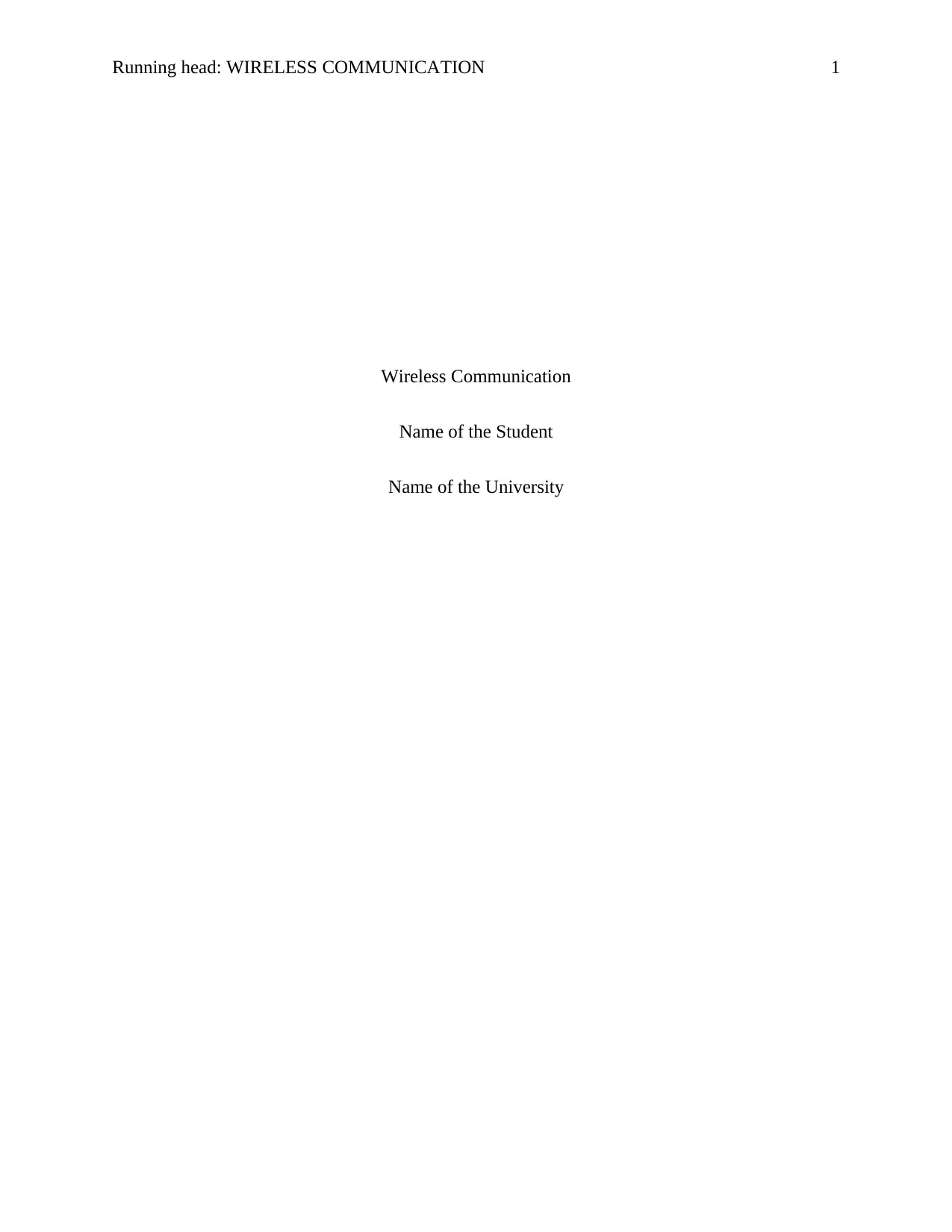
Running head: WIRELESS COMMUNICATION 1
Wireless Communication
Name of the Student
Name of the University
Wireless Communication
Name of the Student
Name of the University
Paraphrase This Document
Need a fresh take? Get an instant paraphrase of this document with our AI Paraphraser
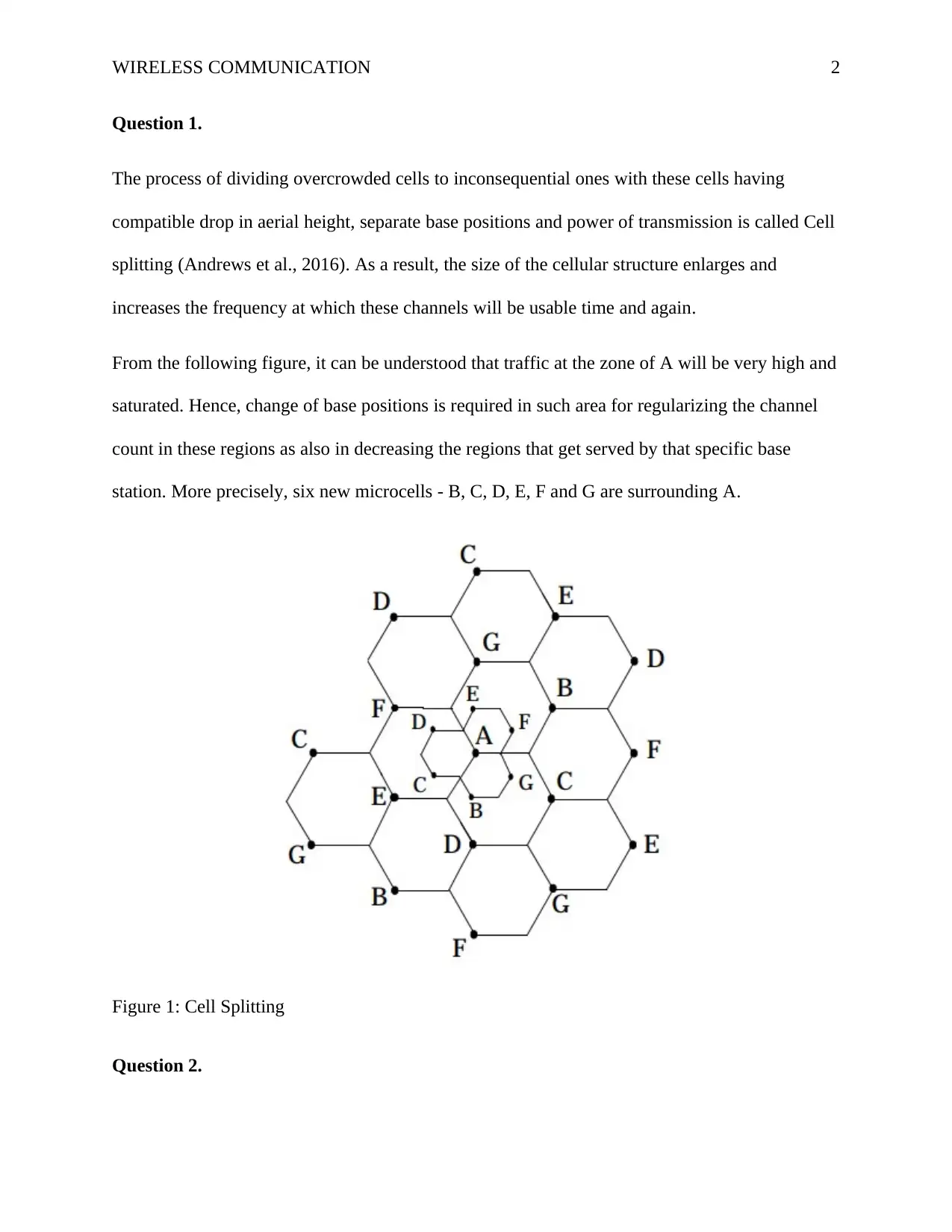
WIRELESS COMMUNICATION 2
Question 1.
The process of dividing overcrowded cells to inconsequential ones with these cells having
compatible drop in aerial height, separate base positions and power of transmission is called Cell
splitting (Andrews et al., 2016). As a result, the size of the cellular structure enlarges and
increases the frequency at which these channels will be usable time and again.
From the following figure, it can be understood that traffic at the zone of A will be very high and
saturated. Hence, change of base positions is required in such area for regularizing the channel
count in these regions as also in decreasing the regions that get served by that specific base
station. More precisely, six new microcells - B, C, D, E, F and G are surrounding A.
Figure 1: Cell Splitting
Question 2.
Question 1.
The process of dividing overcrowded cells to inconsequential ones with these cells having
compatible drop in aerial height, separate base positions and power of transmission is called Cell
splitting (Andrews et al., 2016). As a result, the size of the cellular structure enlarges and
increases the frequency at which these channels will be usable time and again.
From the following figure, it can be understood that traffic at the zone of A will be very high and
saturated. Hence, change of base positions is required in such area for regularizing the channel
count in these regions as also in decreasing the regions that get served by that specific base
station. More precisely, six new microcells - B, C, D, E, F and G are surrounding A.
Figure 1: Cell Splitting
Question 2.
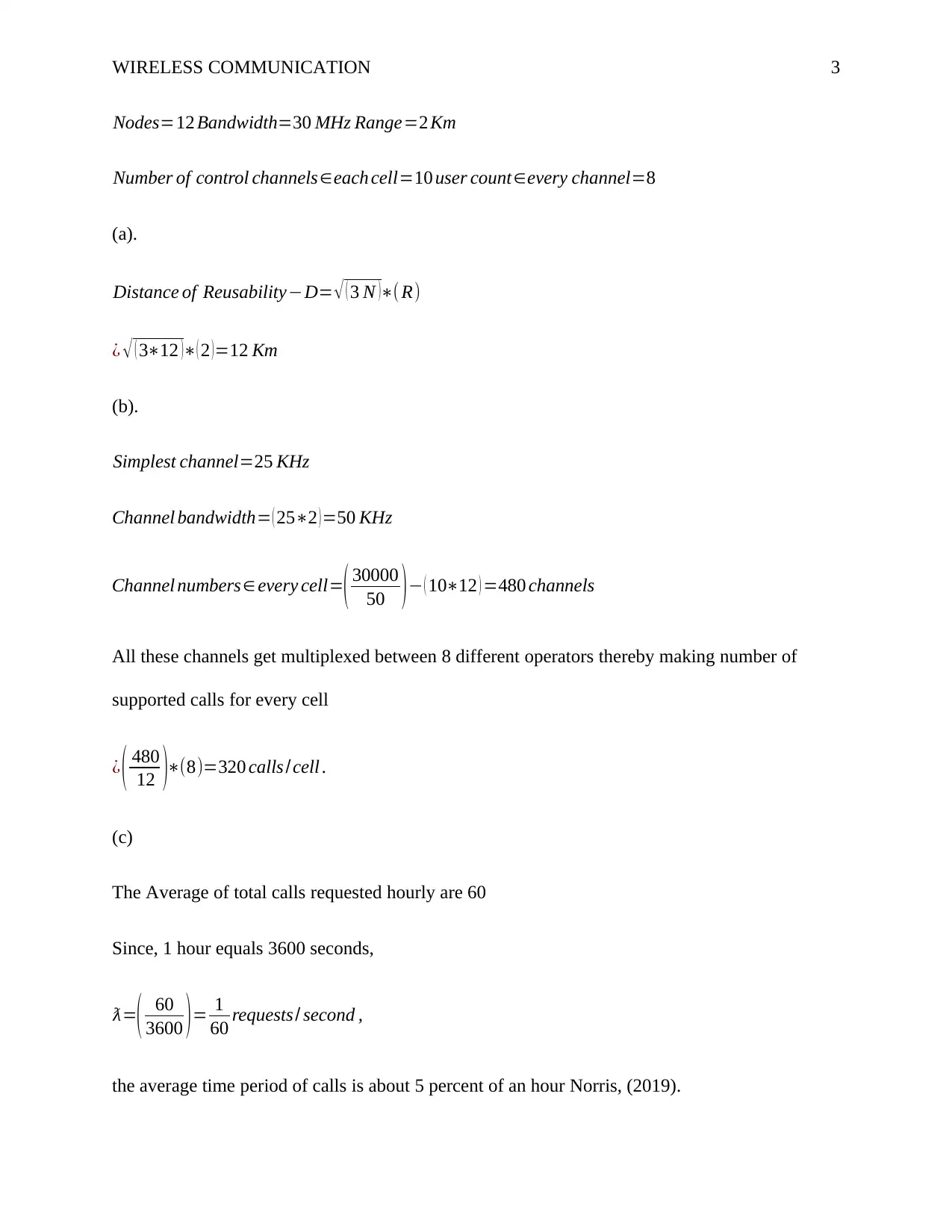
WIRELESS COMMUNICATION 3
Nodes=12 Bandwidth=30 MHz Range=2 Km
Number of control channels∈each cell=10 user count∈every channel=8
(a).
Distance of Reusability−D= √ ( 3 N )∗( R)
¿ √ ( 3∗12 )∗( 2 )=12 Km
(b).
Simplest channel=25 KHz
Channel bandwidth= ( 25∗2 )=50 KHz
Channel numbers∈ every cell=( 30000
50 ) − ( 10∗12 ) =480 channels
All these channels get multiplexed between 8 different operators thereby making number of
supported calls for every cell
¿ ( 480
12 )∗(8)=320 calls /cell .
(c)
The Average of total calls requested hourly are 60
Since, 1 hour equals 3600 seconds,
ƛ=( 60
3600 )= 1
60 requests / second ,
the average time period of calls is about 5 percent of an hour Norris, (2019).
Nodes=12 Bandwidth=30 MHz Range=2 Km
Number of control channels∈each cell=10 user count∈every channel=8
(a).
Distance of Reusability−D= √ ( 3 N )∗( R)
¿ √ ( 3∗12 )∗( 2 )=12 Km
(b).
Simplest channel=25 KHz
Channel bandwidth= ( 25∗2 )=50 KHz
Channel numbers∈ every cell=( 30000
50 ) − ( 10∗12 ) =480 channels
All these channels get multiplexed between 8 different operators thereby making number of
supported calls for every cell
¿ ( 480
12 )∗(8)=320 calls /cell .
(c)
The Average of total calls requested hourly are 60
Since, 1 hour equals 3600 seconds,
ƛ=( 60
3600 )= 1
60 requests / second ,
the average time period of calls is about 5 percent of an hour Norris, (2019).
⊘ This is a preview!⊘
Do you want full access?
Subscribe today to unlock all pages.

Trusted by 1+ million students worldwide
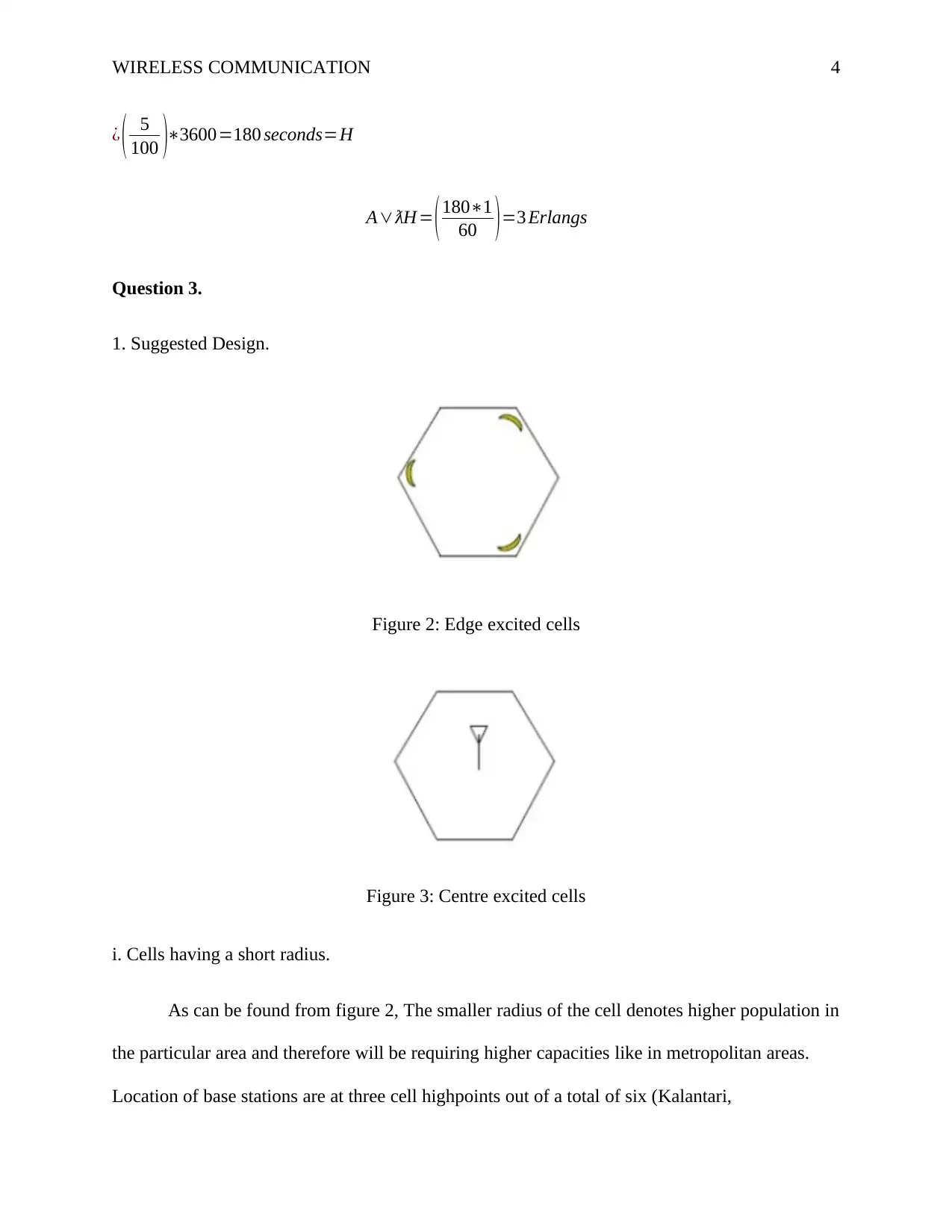
WIRELESS COMMUNICATION 4
¿ ( 5
100 )∗3600=180 seconds=H
A∨ƛH = ( 180∗1
60 ) =3 Erlangs
Question 3.
1. Suggested Design.
Figure 2: Edge excited cells
Figure 3: Centre excited cells
i. Cells having a short radius.
As can be found from figure 2, The smaller radius of the cell denotes higher population in
the particular area and therefore will be requiring higher capacities like in metropolitan areas.
Location of base stations are at three cell highpoints out of a total of six (Kalantari,
¿ ( 5
100 )∗3600=180 seconds=H
A∨ƛH = ( 180∗1
60 ) =3 Erlangs
Question 3.
1. Suggested Design.
Figure 2: Edge excited cells
Figure 3: Centre excited cells
i. Cells having a short radius.
As can be found from figure 2, The smaller radius of the cell denotes higher population in
the particular area and therefore will be requiring higher capacities like in metropolitan areas.
Location of base stations are at three cell highpoints out of a total of six (Kalantari,
Paraphrase This Document
Need a fresh take? Get an instant paraphrase of this document with our AI Paraphraser
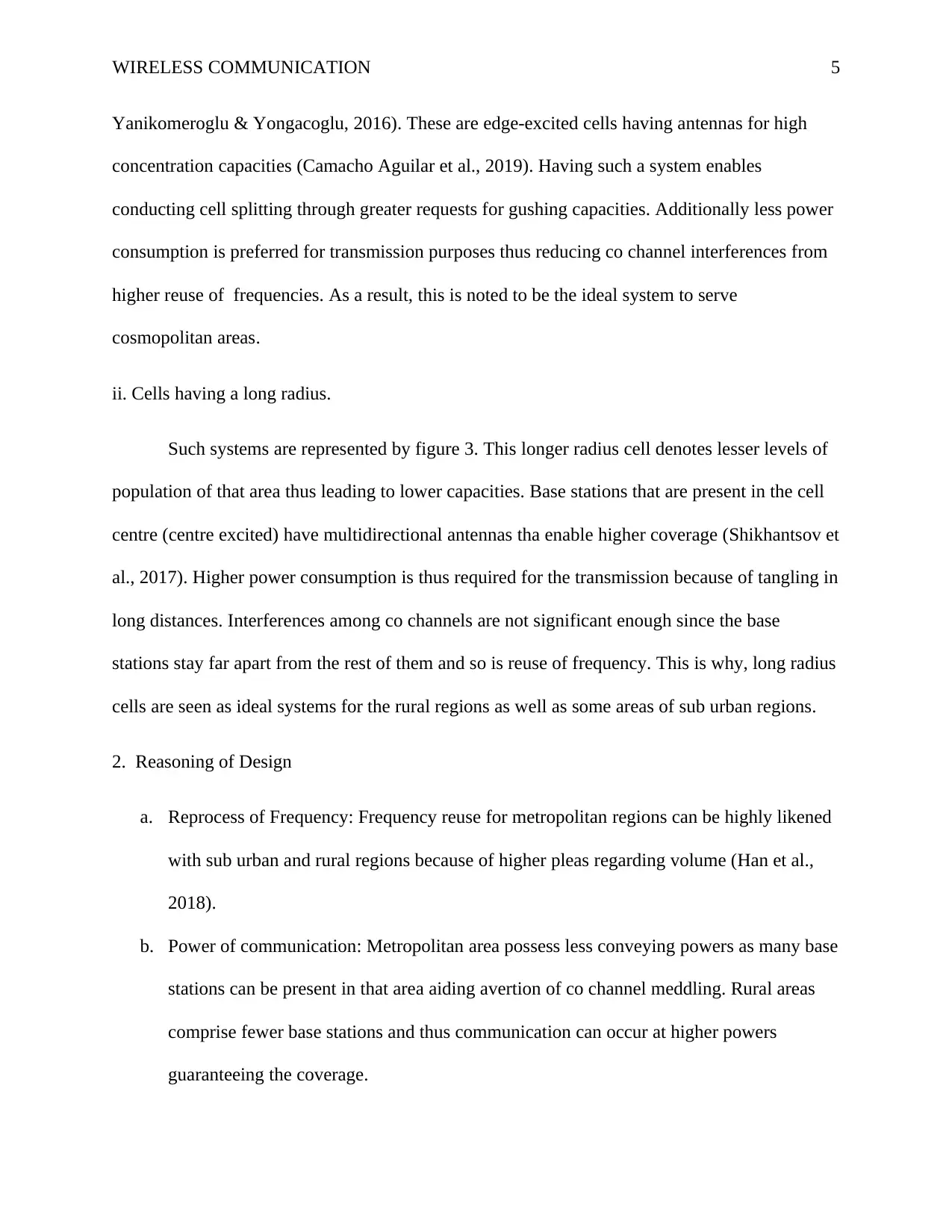
WIRELESS COMMUNICATION 5
Yanikomeroglu & Yongacoglu, 2016). These are edge-excited cells having antennas for high
concentration capacities (Camacho Aguilar et al., 2019). Having such a system enables
conducting cell splitting through greater requests for gushing capacities. Additionally less power
consumption is preferred for transmission purposes thus reducing co channel interferences from
higher reuse of frequencies. As a result, this is noted to be the ideal system to serve
cosmopolitan areas.
ii. Cells having a long radius.
Such systems are represented by figure 3. This longer radius cell denotes lesser levels of
population of that area thus leading to lower capacities. Base stations that are present in the cell
centre (centre excited) have multidirectional antennas tha enable higher coverage (Shikhantsov et
al., 2017). Higher power consumption is thus required for the transmission because of tangling in
long distances. Interferences among co channels are not significant enough since the base
stations stay far apart from the rest of them and so is reuse of frequency. This is why, long radius
cells are seen as ideal systems for the rural regions as well as some areas of sub urban regions.
2. Reasoning of Design
a. Reprocess of Frequency: Frequency reuse for metropolitan regions can be highly likened
with sub urban and rural regions because of higher pleas regarding volume (Han et al.,
2018).
b. Power of communication: Metropolitan area possess less conveying powers as many base
stations can be present in that area aiding avertion of co channel meddling. Rural areas
comprise fewer base stations and thus communication can occur at higher powers
guaranteeing the coverage.
Yanikomeroglu & Yongacoglu, 2016). These are edge-excited cells having antennas for high
concentration capacities (Camacho Aguilar et al., 2019). Having such a system enables
conducting cell splitting through greater requests for gushing capacities. Additionally less power
consumption is preferred for transmission purposes thus reducing co channel interferences from
higher reuse of frequencies. As a result, this is noted to be the ideal system to serve
cosmopolitan areas.
ii. Cells having a long radius.
Such systems are represented by figure 3. This longer radius cell denotes lesser levels of
population of that area thus leading to lower capacities. Base stations that are present in the cell
centre (centre excited) have multidirectional antennas tha enable higher coverage (Shikhantsov et
al., 2017). Higher power consumption is thus required for the transmission because of tangling in
long distances. Interferences among co channels are not significant enough since the base
stations stay far apart from the rest of them and so is reuse of frequency. This is why, long radius
cells are seen as ideal systems for the rural regions as well as some areas of sub urban regions.
2. Reasoning of Design
a. Reprocess of Frequency: Frequency reuse for metropolitan regions can be highly likened
with sub urban and rural regions because of higher pleas regarding volume (Han et al.,
2018).
b. Power of communication: Metropolitan area possess less conveying powers as many base
stations can be present in that area aiding avertion of co channel meddling. Rural areas
comprise fewer base stations and thus communication can occur at higher powers
guaranteeing the coverage.
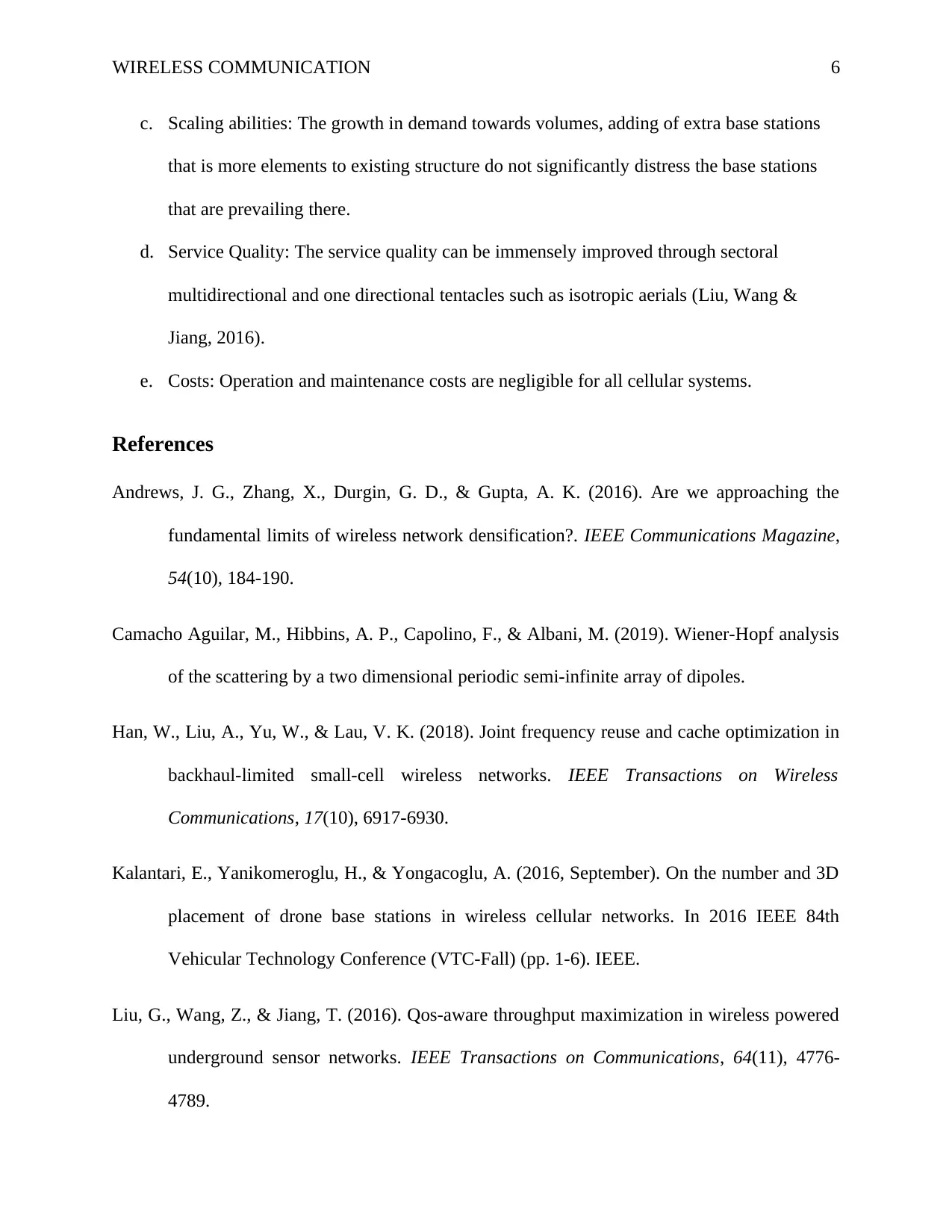
WIRELESS COMMUNICATION 6
c. Scaling abilities: The growth in demand towards volumes, adding of extra base stations
that is more elements to existing structure do not significantly distress the base stations
that are prevailing there.
d. Service Quality: The service quality can be immensely improved through sectoral
multidirectional and one directional tentacles such as isotropic aerials (Liu, Wang &
Jiang, 2016).
e. Costs: Operation and maintenance costs are negligible for all cellular systems.
References
Andrews, J. G., Zhang, X., Durgin, G. D., & Gupta, A. K. (2016). Are we approaching the
fundamental limits of wireless network densification?. IEEE Communications Magazine,
54(10), 184-190.
Camacho Aguilar, M., Hibbins, A. P., Capolino, F., & Albani, M. (2019). Wiener-Hopf analysis
of the scattering by a two dimensional periodic semi-infinite array of dipoles.
Han, W., Liu, A., Yu, W., & Lau, V. K. (2018). Joint frequency reuse and cache optimization in
backhaul-limited small-cell wireless networks. IEEE Transactions on Wireless
Communications, 17(10), 6917-6930.
Kalantari, E., Yanikomeroglu, H., & Yongacoglu, A. (2016, September). On the number and 3D
placement of drone base stations in wireless cellular networks. In 2016 IEEE 84th
Vehicular Technology Conference (VTC-Fall) (pp. 1-6). IEEE.
Liu, G., Wang, Z., & Jiang, T. (2016). Qos-aware throughput maximization in wireless powered
underground sensor networks. IEEE Transactions on Communications, 64(11), 4776-
4789.
c. Scaling abilities: The growth in demand towards volumes, adding of extra base stations
that is more elements to existing structure do not significantly distress the base stations
that are prevailing there.
d. Service Quality: The service quality can be immensely improved through sectoral
multidirectional and one directional tentacles such as isotropic aerials (Liu, Wang &
Jiang, 2016).
e. Costs: Operation and maintenance costs are negligible for all cellular systems.
References
Andrews, J. G., Zhang, X., Durgin, G. D., & Gupta, A. K. (2016). Are we approaching the
fundamental limits of wireless network densification?. IEEE Communications Magazine,
54(10), 184-190.
Camacho Aguilar, M., Hibbins, A. P., Capolino, F., & Albani, M. (2019). Wiener-Hopf analysis
of the scattering by a two dimensional periodic semi-infinite array of dipoles.
Han, W., Liu, A., Yu, W., & Lau, V. K. (2018). Joint frequency reuse and cache optimization in
backhaul-limited small-cell wireless networks. IEEE Transactions on Wireless
Communications, 17(10), 6917-6930.
Kalantari, E., Yanikomeroglu, H., & Yongacoglu, A. (2016, September). On the number and 3D
placement of drone base stations in wireless cellular networks. In 2016 IEEE 84th
Vehicular Technology Conference (VTC-Fall) (pp. 1-6). IEEE.
Liu, G., Wang, Z., & Jiang, T. (2016). Qos-aware throughput maximization in wireless powered
underground sensor networks. IEEE Transactions on Communications, 64(11), 4776-
4789.
⊘ This is a preview!⊘
Do you want full access?
Subscribe today to unlock all pages.

Trusted by 1+ million students worldwide
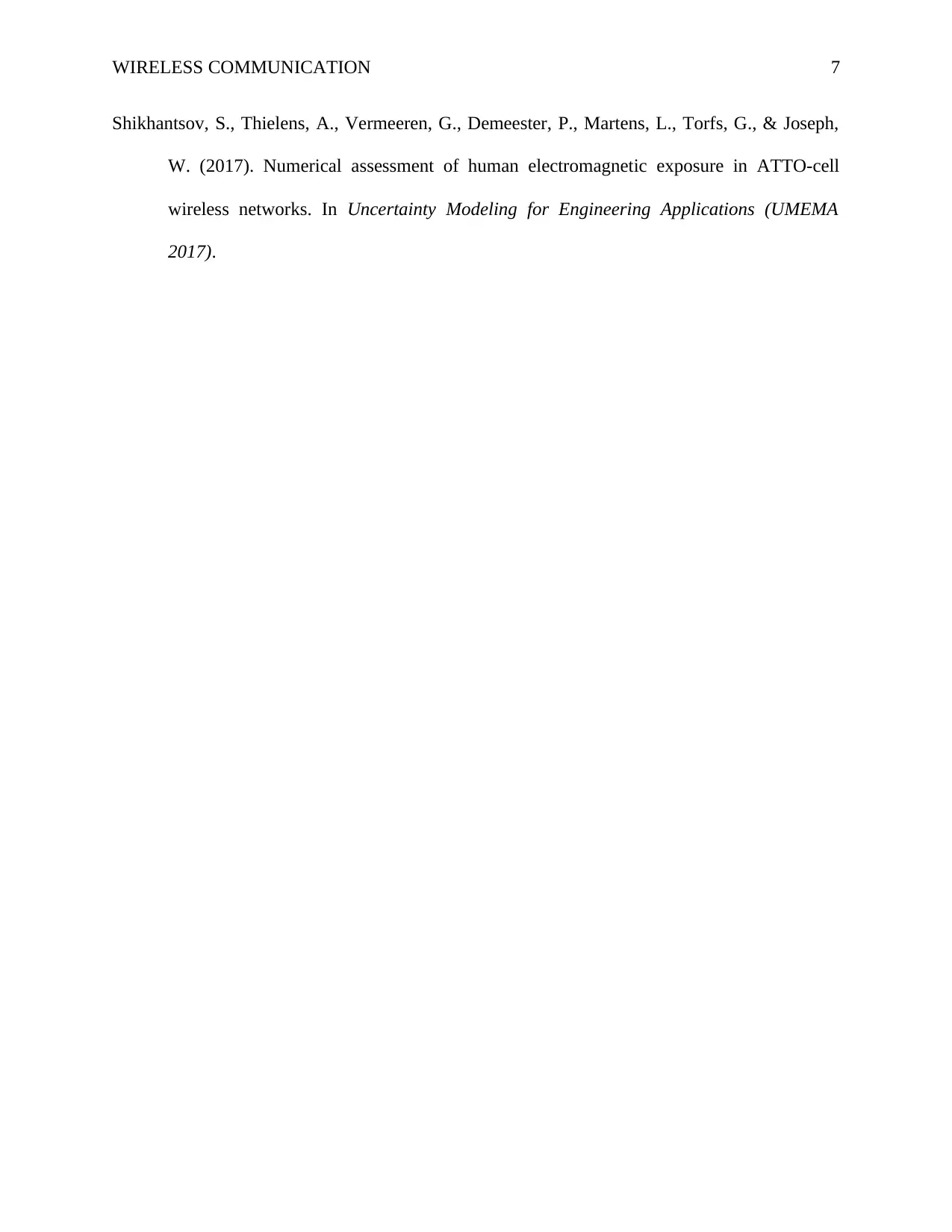
WIRELESS COMMUNICATION 7
Shikhantsov, S., Thielens, A., Vermeeren, G., Demeester, P., Martens, L., Torfs, G., & Joseph,
W. (2017). Numerical assessment of human electromagnetic exposure in ATTO-cell
wireless networks. In Uncertainty Modeling for Engineering Applications (UMEMA
2017).
Shikhantsov, S., Thielens, A., Vermeeren, G., Demeester, P., Martens, L., Torfs, G., & Joseph,
W. (2017). Numerical assessment of human electromagnetic exposure in ATTO-cell
wireless networks. In Uncertainty Modeling for Engineering Applications (UMEMA
2017).
1 out of 7
Related Documents
Your All-in-One AI-Powered Toolkit for Academic Success.
+13062052269
info@desklib.com
Available 24*7 on WhatsApp / Email
![[object Object]](/_next/static/media/star-bottom.7253800d.svg)
Unlock your academic potential
Copyright © 2020–2025 A2Z Services. All Rights Reserved. Developed and managed by ZUCOL.





